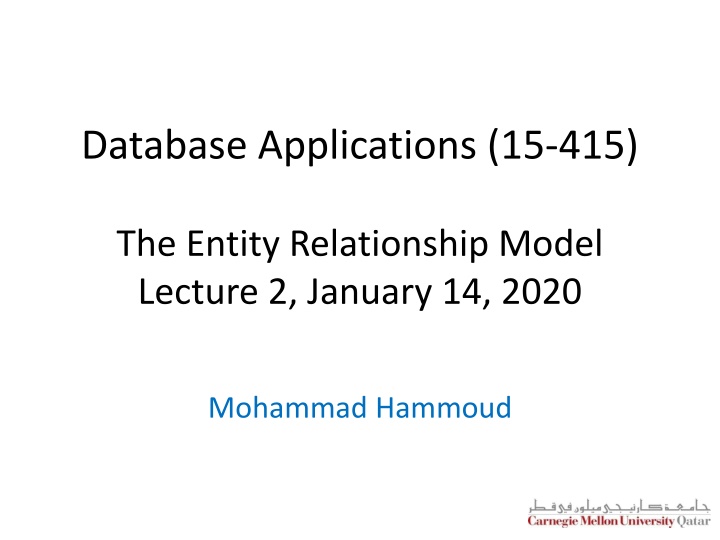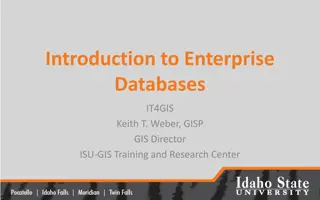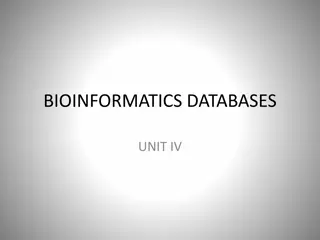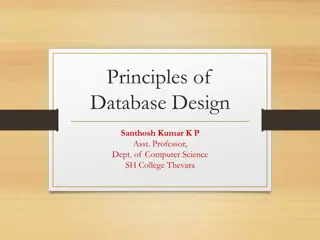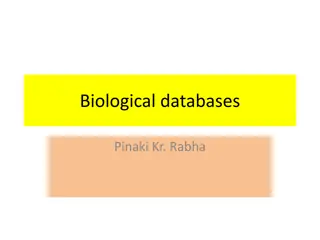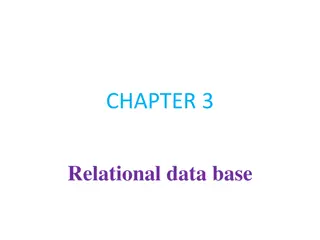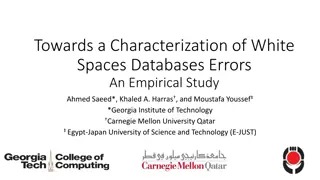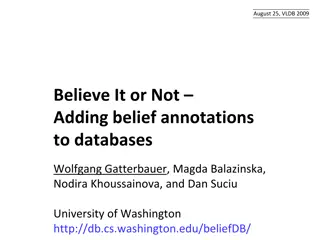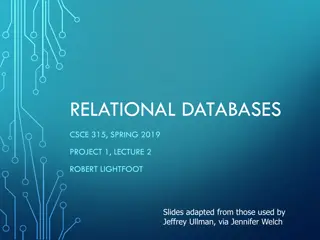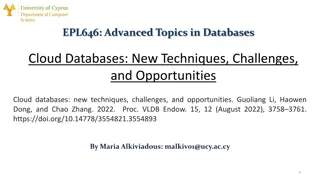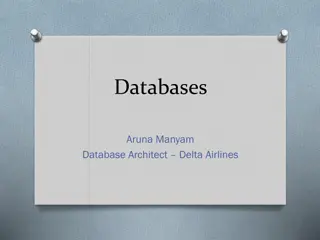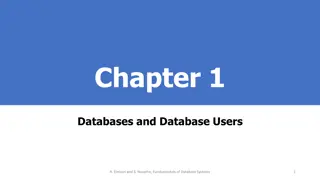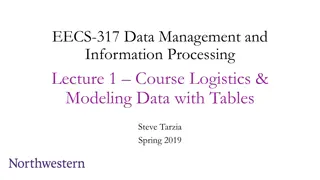Introduction to Databases and ER Model
Fundamental concepts of databases, including the entity-relationship model, database design, levels of abstraction, views, and data independence. Learn about the main steps in designing databases, integrity constraints in the ER model, and the benefits of using a DBMS for data independence. Dive into constructs and constraints of the ER model, schema descriptions, and the significance of conceptual, physical, and external schemas in database management systems.
Download Presentation

Please find below an Image/Link to download the presentation.
The content on the website is provided AS IS for your information and personal use only. It may not be sold, licensed, or shared on other websites without obtaining consent from the author.If you encounter any issues during the download, it is possible that the publisher has removed the file from their server.
You are allowed to download the files provided on this website for personal or commercial use, subject to the condition that they are used lawfully. All files are the property of their respective owners.
The content on the website is provided AS IS for your information and personal use only. It may not be sold, licensed, or shared on other websites without obtaining consent from the author.
E N D
Presentation Transcript
Database Applications (15-415) The Entity Relationship Model Lecture 2, January 14, 2020 Mohammad Hammoud
Today Last Session: Course overview and a brief introduction to databases Today s Session: Introduction to databases and database systems (Continue) Main steps involved in designing databases Constructs of the entity relationship (ER) model Integrity constrains that can be expressed in the ER model Announcements: The first Problem Solving Assignment (PS1) will be posted by tonight on the course webpage. It is due on January 26 by midnight Thursday, January 16 is the first recitation A case study on the ER model will be solved together
Outline A Primer on Databases Database Design ER Model: Constructs and Constraints
Levels of Abstraction The data in a DBMS is described at three levels of abstraction, the conceptual (or logical), physical and external schemas View 1 View 2 View 3 The conceptual schema describes data in terms of a specific data model (e.g., the relational model of data) Conceptual Schema Physical Schema The physical schema specifies how data described in the conceptual schema are stored on secondary storage devices Disk The external schema (or views) allow data access to be customized at the level of individual users or group of users (views can be 1 or many)
Views A view is conceptually a relation Records in a view are computed as needed and usually not stored in a DBMS Example: University Database Conceptual Schema Physical Schema External Schema (View) Students(sid: string, name: string, login: string, dob: string, gpa:real) Courses(cid: string, cname:string, credits:integer) Enrolled(sid:string, cid:string, grade:string) Relations stored as heap files Index on first column of Students Students can be allowed to find out course enrollments: Course_info(cid: string, enrollment: integer) Can be computed from the relations in the conceptual schema (so as to avoid data redundancy and inconsistency).
Iterating: Data Independence One of the most important benefits of using a DBMS is data independence With data independence, application programs are insulated from how data are structured and stored Data independence entails two properties: Logical data independence: users are shielded from changes in the conceptual schema (e.g., add/drop a column in a table) Physical data independence: users are shielded from changes in the physical schema (e.g., add index or change record order)
Queries in a DBMS The ease (plus efficiency & effectiveness) with which information can be queried from a database determines its value to users A DBMS provides a specialized language, called the query language, in which queries can be posed The relational model supports powerful query languages Relational calculus: a formal language based on mathematical logic Relational algebra: a formal language based on a collection of operators (e.g., selection and projection) for manipulating relations Structured Query Language (SQL): Builds upon relational calculus and algebra Allows creating, manipulating and querying relational databases Can be embedded within a host language (e.g., Java)
Concurrent Execution and Transactions An important task of a DBMS is to schedule concurrent accesses to data so as to improve performance T1 T2 R(A) W(A) An atomic sequence of database actions (read/writes) is referred to as transaction R(B) W(B) R(C) W(C) When several users access a database concurrently, the DBMS must order their requests carefully to avoid conflicts E.g., A check might be cleared while account balance is being computed! DBMS ensures that conflicts do not arise via using a locking protocol Shared vs. Exclusive locks
Ensuring Atomicity Transactions can be interrupted before running to completion for a variety of reasons (e.g., due to a system crash) DBMS ensures atomicity (all-or-nothing property) even if a crash occurs in the middle of a transaction This is achieved via maintaining a log (i.e., history) of all writes to the database Before a change is made to the database, the corresponding log entry is forced to a safe location (this protocol is called Write-Ahead Log or WAL) After a crash, the effects of partially executed transactions are undone using the log
The Architecture of a Relational DBMS SQL Interface Web Forms Application Front Ends SQL Commands Plan Executer Parser Query Evaluation Engine Operator Evaluator Optimizer Files and Access Methods Transaction Manager Recovery Manager Buffer Manager Lock Manager Disk Space Manager DBMS Concurrency Control Index Files Data Files Database System Catalog
People Who Work With Databases There are five classes of people associated with databases: 1. End users Store and use data in DBMSs Usually not computer professionals 2. Application programmers Develop applications that facilitate the usage of DBMSs for end-users Computer professionals who know how to leverage host languages, query languages and DBMSs altogether 3. Database Administrators (DBAs) Design the conceptual and physical schemas Ensure security and authorization Ensure data availability and recovery from failures Perform database tuning 4. Implementers Build DBMS software for vendors like IBM and Oracle Computer professionals who know how to build DBMS internals 5. Researchers Innovate new ideas which address evolving and new challenges/problems
The Architecture of a Relational DBMS SQL Interface Application Programmers & DBAs Web Forms Application Front Ends End Users (e.g., university staff, travel agents, etc.) SQL Commands Plan Executer Parser Query Evaluation Engine Operator Evaluator Optimizer Files and Access Methods Transaction Manager Recovery Manager Buffer Manager Implementers and Researchers Lock Manager Disk Space Manager DBMS Concurrency Control Index Files Data Files Database System Catalog
Summary We live in a world of data The explosion of data is occurring along the 3Vs dimensions DBMSs are needed for ensuring logical and physical data independence and ACID properties, among others The data in a DBMS is described at three levels of abstraction A DBMS typically has a layered architecture
Summary Studying DBMSs is one of the broadest and most exciting areas in computer science! This course provides an in-depth treatment of DBMSs with an emphasis on how to design, create, refine, use and build DBMSs and real-world enterprise databases Various classes of people who work with databases hold responsible jobs and are well-paid!
Outline A Primer on Databases Database Design ER Model: Constructs and Constraints
Database Design Requirements Analysis Users needs Conceptual Design A high-level description of the data (e.g., using the ER model) Logical Design The conversion of an ER design into a relational database schema Schema Refinement Normalization (i.e., restructuring tables to ensure some desirable properties) Physical Design Building indexes and clustering some tables Security Design Access controls
Outline A Primer on Databases Database Design ER Model: Constructs and Constraints
Entities and Entity Sets Entity: A real-world object distinguishable from other objects in an enterprise (e.g., University, Students and Faculty) Described using a set of attributes Entity set: A collection of similar entities (e.g., all employees) All entities in an entity set have the same set of attributes (until we consider ISA hierarchies, anyway!) Each entity set has a key Each attribute has a domain
Tools and An ER Diagram Entities ( Entity Sets ) Attributes name ssn lot ssn is the primary key, hence, underlined Employees
Relationship and Relationship Sets Relationship: Association among two or more entities (e.g., Mohammad is teaching 15-415) Described using a set of attributes Relationship set: Collection of similar relationships Same entity set could participate in different relationship sets, or in different roles in the same set
More Tools and ER Diagrams N M Relationships ( rel. sets ) and mapping constraints P name ssn lot since name dname Employees ssn budget lot did super- visor subor- dinate Works_In Employees Departments Reports_To A Binary Relationship A Self-Relationship
Ternary Relationships Suppose that departments have offices at different locations and we want to record the locations at which each employee works Consequently, we must record an association between an employee, a department and a location since name dname ssn budget lot did Works_In Employees Departments address Locations capacity This is referred to as a Ternary Relationship (vs. Self & Binary Relationships)
Key Constraints Consider the Employees and Departments entity sets with a Manages relationship set An employee can work in many departments A department can have many employees Each department can have at most one manager This restriction is an example of a key constraint since name dname ssn lot did budget Employees Manages Departments Key constraints are denoted by thin arrows
Cardinalities Entities can be related to one another as one-to-one , one-to- many and many-to-many This is said to be the cardinality of a given entity in relation to another 1 1 1 N One-to-One Many-to-One One-to-Many Many-to-Many N M
Cardinalities: Examples 1 1 has CAPITAL COUNTRY 1 N owns CAR PERSON N M takes SECTION STUDENT
Cardinalities: Examples has CAPITAL COUNTRY Book s notation: owns CAR PERSON takes SECTION STUDENT
Cardinalities: Examples 1 1 has CAPITAL COUNTRY Book s notation vs 1 to N notation 1 N owns CAR PERSON N M takes SECTION STUDENT
A Working Example Requirements: Students take courses offered by instructors; a course may have multiple sections; one instructor per section How to start? Nouns -> entity sets Verbs -> relationship sets
... name STUDENT ssn INSTRUCTOR issn Primary key = unique identifier underline
... name STUDENT c-id ssn c-name COURSE INSTRUCTOR issn But: sections of a course (with different instructors)?
ssn STUDENT c-id COURSE SECTION s-id But: s-id is not unique... (see later) INSTRUCTOR issn
ssn STUDENT c-id COURSE SECTION s-id Q: how to record that students take courses? INSTRUCTOR issn
ssn STUDENT N c-id takes M COURSE s-id SECTION INSTRUCTOR issn
STUDENT N c-id takes M s-id SECTION COURSE N teaches 1 INSTRUCTOR
STUDENT N c-id takes M 1 N has s-id SECTION COURSE N teaches 1 INSTRUCTOR
Participation Constraints Consider again the Employees and Departments entity sets as well as the Manages relationship set Should every department have a manager? If so, this is a participation constraint Such a constraint entails that every Departments entity must appear in an instance of the Manages relationship The participation of Departments in Manages is said to be total (vs. partial) since since name name dname dname ssn did did budget budget lot Departments Employees Manages Works_In Total participation + key constraint are denoted by a thick arrow Total participation is denoted by a thick line since
Total vs. Partial Participations Total, Total has CAPITAL COUNTRY owns CAR ?? PERSON takes SECTION ?? STUDENT
Total vs. Partial Participations Total, Total has CAPITAL COUNTRY owns CAR Partial, Total PERSON takes SECTION ?? STUDENT
Total vs. Partial Participations Total, Total has CAPITAL COUNTRY owns CAR Partial, Total PERSON takes SECTION Partial, Total STUDENT
Weak Entities A weak entity can be identified uniquely only by considering the primary key of another (owner) entity Owner entity set and weak entity set must participate in a one- to-many relationship set (one owner, many weak entities) Weak entity set must have total participation in this identifying relationship set The set of attributes of a weak entity set that uniquely identifies a weak entity for a given owner entity is called partial key
Weak Entities: An Example Dependents has no unique key of its own Dependents is a weak entity with partial key pname Policy is an identifying relationship set pname + ssn are the primary key of Dependents Partial keys are underlined using broken lines name cost pname age ssn lot Policy Dependents Employees Weak entities and identifying relationships are drawn using thick lines
ISA (`is a) Hierarchies Entities in an entity set can sometimes be classified into subclasses (this is kind of similar to OOP languages) If we declare B ISA A, every B entity is also considered to be an A entity name ssn lot Hourly_Emps and Contract_Emps are generalized by Employees Employees is specialized into subclasses Employees hours_worked hourly_wages ISA contractid Contract_Emps Hourly_Emps
Overlap and Covering Constraints Overlap constraints Can an entity belong to both B and C ? A Covering constraints Can an A entity belong to neither B nor C ? B C
Overlap Constraints: Examples Overlap constraints Can John be in Hourly_Emps and Contract_Emps? Intuitively, no A Can John be in Contract_Emps and in Senior_Emps? Intuitively, yes Contract_Emps OVERLAPS Senior_Emps B C
Covering Constraints: Examples Covering constraints Does every one in Employees belong to a one of its subclasses? Intuitively, no A Does every Motor_Vehicles entity have to be either a Motorboats entity or a Cars entity? Intuitively, yes Motorboats AND Cars COVER Motor_Vehicles B C
More Details on ISA Hierarchies Attributes are inherited (i.e., if B ISA A, the attributes defined for a B entity are the attributes for A plus B) We can have many levels of an ISA hierarchy Reasons for using ISA: To add descriptive attributes specific to a subclass To identify entities that participate in a relationship
Aggregation Aggregation allows indicating that a relationship set (identified through a dashed box) participates in another relationship set name ssn lot Employees Monitors until since started_on dname pid pbudget did budget Sponsors Departments Projects
Next Class Continue the ER Model and Start with the relational Model
